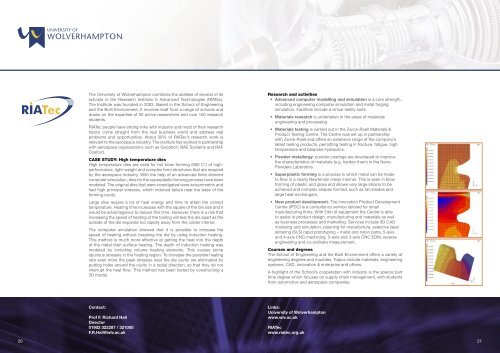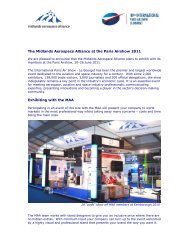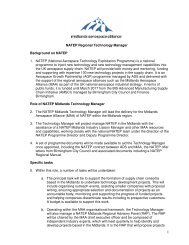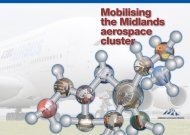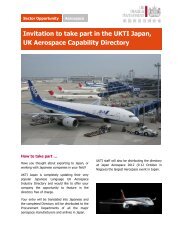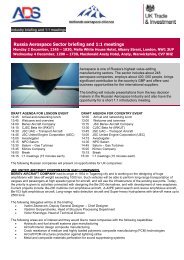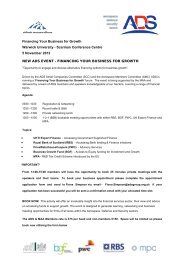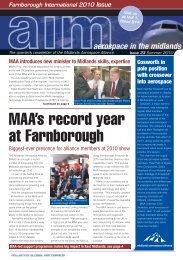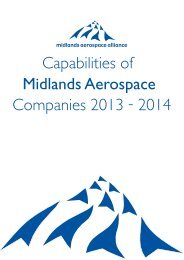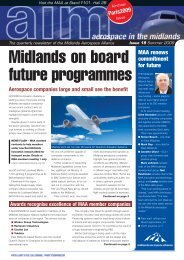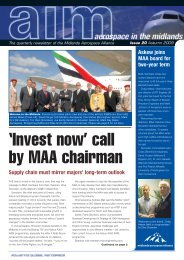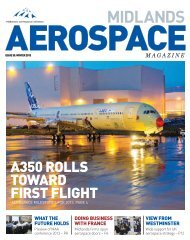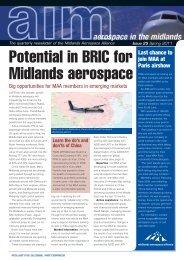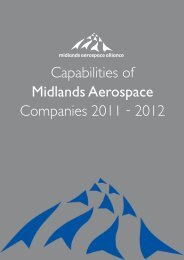new technology for aerospace
here - Midlands Aerospace Alliance
here - Midlands Aerospace Alliance
You also want an ePaper? Increase the reach of your titles
YUMPU automatically turns print PDFs into web optimized ePapers that Google loves.
The University of Wolverhampton combines the abilities of several of its<br />
schools in the Research Institute in Advanced Technologies (RIATec).<br />
The Institute was founded in 2003. Based in the School of Engineering<br />
and the Built Environment, it involves staff from a range of schools and<br />
draws on the expertise of 50 active researchers and over 100 research<br />
students.<br />
RIATec people have strong links with industry and most of their research<br />
topics come straight from the real business world and address real<br />
problems and opportunities. About 30% of RIATec’s research work is<br />
relevant to the <strong>aerospace</strong> industry. The institute has worked in partnership<br />
with <strong>aerospace</strong> organisations such as Goodrich, BAE Systems and RAF<br />
Cos<strong>for</strong>d.<br />
CASE STUDY: High temperature dies<br />
High temperature dies are used <strong>for</strong> hot blow <strong>for</strong>ming (900 C°) of highper<strong>for</strong>mance,<br />
light-weight and complex <strong>for</strong>m structures that are required<br />
by the <strong>aerospace</strong> industry. With the help of an advanced finite element<br />
computer simulation, dies <strong>for</strong> the superplastic <strong>for</strong>ming process have been<br />
modeled. The original dies that were investigated were axisymmetric and<br />
had high principal stresses, which induced failure near the base of the<br />
<strong>for</strong>ming cavity.<br />
Large dies require a lot of heat energy and time to attain the correct<br />
temperature. Heating time increases with the square of the die size and it<br />
would be advantageous to reduce this time. However, there is a risk that<br />
increasing the speed of heating of the tooling will tear the die apart as the<br />
outside of the die expands too rapidly away from the colder interior.<br />
The computer simulation showed that it is possible to increase the<br />
speed of heating without breaking the die by using induction heating.<br />
This method is much more effective at getting the heat into the depth<br />
of the metal than surface heating. The depth of induction heating was<br />
modeled by including volume heating elements. This causes some<br />
spurious stresses in the heating region. To increase the possible heating<br />
rate even more the peak stresses near the die cavity are eliminated by<br />
putting holes around the cavity in a radial direction, so that they do not<br />
interrupt the heat flow. This method has been tested by constructing a<br />
3D model.<br />
Research and activities<br />
• Advanced computer modelling and simulation is a core strength,<br />
including engineering computer simulation and metal <strong>for</strong>ging<br />
simulation. Facilities include a virtual reality suite.<br />
• Materials research is undertaken in the areas of materials<br />
engineering and processing<br />
• Materials testing is carried out in the Zwick-Roell Materials &<br />
Product Testing Centre. The Centre was set up in partnership<br />
with Zwick-Roell and offers an extensive range of the company’s<br />
latest testing products, permitting testing in fracture, fatigue, high<br />
temperature and bespoke hydraulics.<br />
• Powder metallurgy: powder coatings are developed to improve<br />
the characteristics of materials (e.g. harden them) in the Nano-<br />
Powders Laboratory.<br />
• Superplastic <strong>for</strong>ming is a process in which metal can be made<br />
to flow in a nearly Newtonian creep manner. This is seen in blow<br />
<strong>for</strong>ming of plastic and glass and allows very large strains to be<br />
achieved and complex shapes <strong>for</strong>med, such as fan-blades and<br />
large heat-exchangers.<br />
• New product development: The Innovation Product Development<br />
Centre (IPDC) is a consultancy service tailored <strong>for</strong> small<br />
manufacturing firms. With £4m of equipment the Centre is able<br />
to assist in product design, manufacturing and materials as well<br />
as business processes and marketing. Services include 3D CAD<br />
modeling and simulation, planning <strong>for</strong> manufacture, selective laser<br />
sintering (SLS) rapid prototyping – metal and nylon parts, 5-axis<br />
and 4-axis CNC machining, 5-axis and 3-axis CNC EDM, reverse<br />
engineering and co-ordinate measurement.<br />
Courses and degrees<br />
The School of Engineering and the Built Environment offers a variety of<br />
engineering degrees and modules. Topics include materials, engineering<br />
systems, CAD, innovation & enterprise and others.<br />
A highlight of the School’s cooperation with industry is the special part<br />
time degree which focuses on supply chain management, with students<br />
from automotive and <strong>aerospace</strong> companies.<br />
Contact:<br />
Prof F. Richard Hall<br />
Director<br />
01902 322287 / 321000<br />
F.R.Hall@wlv.ac.uk<br />
Links:<br />
University of Wolverhampton<br />
www.wlv.ac.uk<br />
RIATec<br />
www.riatec.org.uk<br />
20 21


